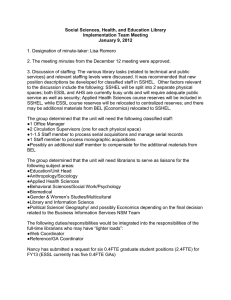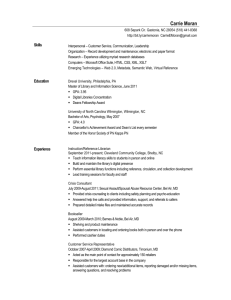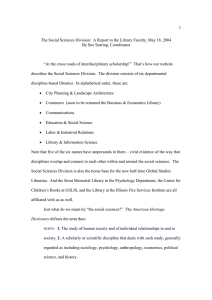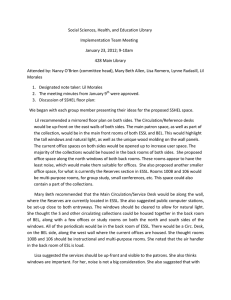On behalf of the members of the Social Sciences Division,... documents to the Administrative Council:
advertisement
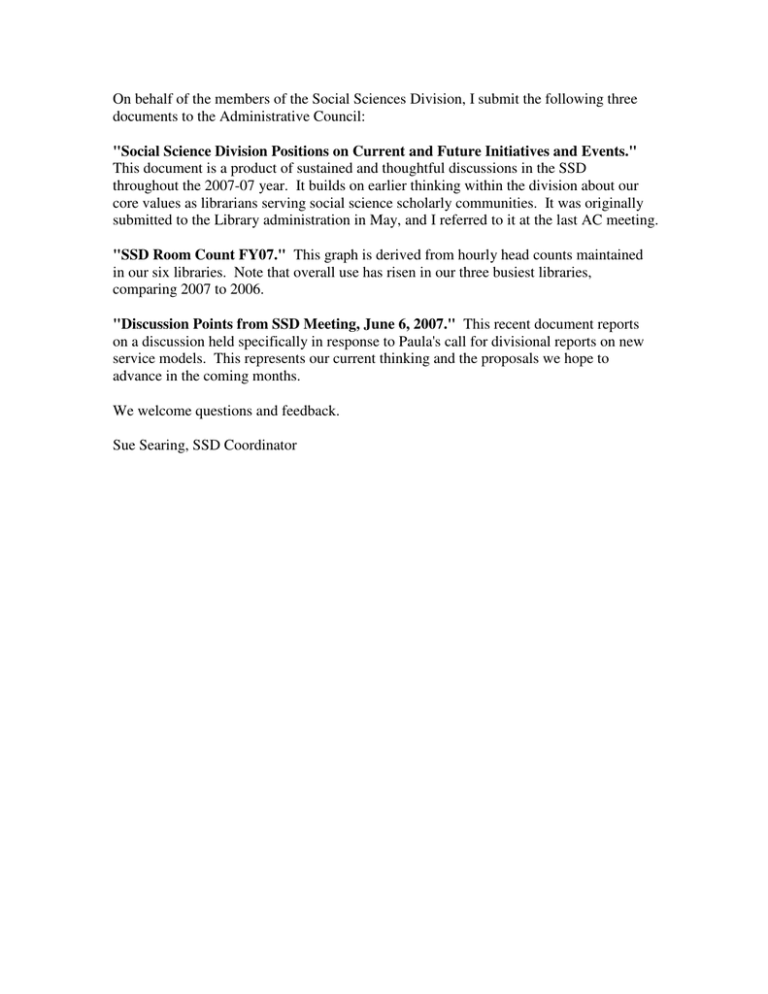
On behalf of the members of the Social Sciences Division, I submit the following three documents to the Administrative Council: "Social Science Division Positions on Current and Future Initiatives and Events." This document is a product of sustained and thoughtful discussions in the SSD throughout the 2007-07 year. It builds on earlier thinking within the division about our core values as librarians serving social science scholarly communities. It was originally submitted to the Library administration in May, and I referred to it at the last AC meeting. "SSD Room Count FY07." This graph is derived from hourly head counts maintained in our six libraries. Note that overall use has risen in our three busiest libraries, comparing 2007 to 2006. "Discussion Points from SSD Meeting, June 6, 2007." This recent document reports on a discussion held specifically in response to Paula's call for divisional reports on new service models. This represents our current thinking and the proposals we hope to advance in the coming months. We welcome questions and feedback. Sue Searing, SSD Coordinator Social Science Division Positions on Current and Future Initiatives and Events Introduction The following pages suggest possible scenarios for the Social Sciences Division with regard to current and future initiatives and events which may impact the Division’s unit libraries. The initiatives and events discussed here may originate at the Library, University, State, or perhaps even National level. They also may include predicted future shifts in user behavior that warrant comment from the Division. The Guiding Principles of the Social Sciences Division, finalized in August 2006, provide the structure for analysis of the proposals that are currently being considered and implemented within the University Library. 1. Service Delivery – Hours, locations, and methods of service delivery support the goal of making assistance available to the user when, where, and how such assistance is needed. 2. Subject expertise – Deep subject knowledge provides more benefit to the user when it is aligned with academic and inter-disciplinary subjects rather than Library unit/division designations. 3. Collections – Medium and format of resources should reflect the preferences of the user group, but we will be mindful of the fact that we are a great research institution with the obligation to retain and archive resources as well as provide them to our current users. Social Science Scholarly Commons Scenario Physical locations remain basically unchanged. As more resources become electronic, we move all periodical collections to Main Stacks and move in more computing resources for our users. A Social Science Scholars Commons is created on the first floor in what is now Room 104. Cooperative reference services are delivered from this area on a regularly scheduled basis by all of the social science subject specialists within the Main Library. In addition to regularly scheduled reference desk hours, all subject specialists from the Main Library spend some time in their departments and schedule regular office hours for users. All cataloging and all acquisitions check-in are done through centralized technical services. The School and Curriculum Collections are unified and moved to the area where the former IRRC office is in the northwest corner of the building or to the area currently housing the EDX circulating collection. The interior of room 100 is turned into the EDX circulating collection and the rooms housing the School Collection and the Curriculum Collection become an area providing reference materials and workstations. The wall between these areas and room 104 is opened up as the main access point. BEL’s entry area remains an area for computing, and the BEL stacks are turned into group study areas. The Business Office is the site of centralized access services and pick-up. The Library and Information Science Library exists as a separate unit but may have modified services. Radical Realignment Scenario If the Scholarly Commons comes to fruition, if the Access Services Department becomes a reality, and if the tenets of the Shepley-Bulfinch report are actualized, the units of the Social Science Division in the Main Library may undergo drastic change. Assuming all of this does become a reality, the following reconfiguration is possible: The location currently occupied by the Business Office will be opened up and will provide the physical location for the Access Services Department where items that have been remotely requested can be picked up. This would include items from all over the Main Library, outlying units, and interlibrary loan. The physical materials from the Library Science Library and the Business and Economics Library would be integrated into the larger social sciences collection that would reside in the reconfigured space that currently houses the Education and Social Science Library. It is also possible that the print monographs of the Applied Life Studies Library and the Government Documents Library would reside there as well. The area would contain a circulating collection of monographs and those periodicals that have not been flipped to e-only will be moved to Main Stacks. Those special collections that cannot be absorbed into the larger collection, the School Collection and the Curriculum Collection, will be placed in the “Special Collections Wing” of the building or at the very least, collocated and placed in an area that is large enough for this to happen. A clerk in charge of circulation of the materials would be available to assist users in this area and a circulation desk would still be staffed. All librarians would have offices on the third floor of the Main Library. Reference services will either be offered through a centralized Main Library service (if that comes to fruition) or the Social Sciences will provide reference services to users in a clearly defined way, including a designated service desk. In addition to providing reference services at a central desk during regularly scheduled hours, librarians would have specific office hours both in their space in the Main Library and in their respective departments. All aspects of technical support – call slip pick up, check-in for acquisitions, shelving, etc. – would be provided through central services. The area currently occupied by BEL would be developed into a computing resource lab that would include the databases currently in use in BEL as well as multiple workstations with access to production tools and library-wide databases. This area might also include access to the statistical resources currently being delivered by ATLAS (both consulting and access to statistical databases) and support for GIS resources. Small areas for group work and discussion would be configured with some degree of sound-proofing. The areas currently taken up by staff offices and the computer lab in BEL would be changed to quiet study areas. Status Quo Scenario Locations and services remain basically as they currently exist. For additional reading: http://library.nyu.edu/about/KPLReport.pdf FYO6 SSD Room Counts 30 BEL Average People / Hour CMX 25 CPL ESSL Labor 20 LIS 15 10 5 0 Aug Sep Oct Nov Dec Jan Feb Mar Apr May Jun Jul FYO7 SSD Room Counts 30 BEL Average People / Hour CMX 25 CPL ESSL 20 Labor LIS 15 10 5 0 Aug Sep Oct Nov Dec Jan Feb Mar Apr May Jun Jul Discussion Points from SSD Meeting June 6, 2007 Discussion Question: “New Service Models: What can the SSD do immediately to move the Library forward? What steps can we take now toward the SSD vision of the future?” The framing documents: SSD Room Counts and the SSD Position on Current and Future Initiatives What we do know: The three busiest libraries in FY06 got busier in FY07. Factors: • BEL: Increased instruction and group work, most especially in the area of Finance • ESSL: More workstations • CMX: Increased enrollment and marketing Examples of things we are already doing in new service models: • • • • • • Women and Gender Studies librarian has more of a presence by going to where the researchers are and is working more in ESSL. LIS, BEL, and CPLA have also experimented with service hours outside the library. ESSL has volunteers from CPS in providing reference service. More data is being extracted on web site usage (Global Studies). More resources being moved to the user’s desktop (LIS). Labor is operated as a satellite library of BEL. Business and Finance Librarian is teaching a course in Financial Information Systems, which means more library instruction is becoming embedded into the curriculum. What steps can be taken: • Accept proposal by Nancy, Lynne, and Lisa to transfer funds and some of the collection from Speech Communication fund as there is more interdisciplinary work between the department and the College. • As there will be a formation of a Roger Ebert Cinema Studies Center and the Cinema Studies group is being folded into the College of Communications, we will propose to the Humanities Division, EC, and Administration that Cinema Studies funds and the AP who selects could be transferred to the Communications Library. This will help facilitate further the Humanities Scholarly Commons. • CPLA’s collection can be moved into Funk by August 2008, and perhaps the staff member may be moved with the collection (or somewhere else); collaboration with Ricker for service will continue. • Move links to subject specialist/departmental library IM services above the fold on the Ask –a –Librarian page . At the moment, subject specialists who participate in the service are invisible to users unless they know to go to Unit Library’s page. This will provide better subject knowledge to the user anywhere, rather than the library unit designation. It will also facilitate cooperation across units and make it easier to do referrals on the fly. • Labor Library can be transformed into more of a collaborative learning space for students, with an office for a librarian and materials moved to Oak Street or stacks by 2009. • LIS Library can conduct formal and informal user needs assessment with GSLIS faculty and students and Library faculty during 2007-08 academic year, and can explore assessment methodologies that might include other libraries with low onsite use. Targeted user needs assessment will clarify in advance the benefits and/or losses to user communities of consolidating or eliminating service points; will provide data for decision-making; and will signal the Library’s commitment to transformation. Library-wide surveys do not provide sufficiently detailed data on the smaller libraries for these purposes. Other ideas suggested: • Disperse LIS materials and perhaps share staff with Central Ref, ESSL, or Communications. Challenges with the suggested steps to be taken: • Resource allocation to take steps is unpredictable as the legislature and the governor often do not come until an agreement close to July 1. • Decision making has been slow and hesitant on many of the suggestions due to several factors (changing administration, etc) but also lack of clear direction. Clear goals are needed to proceed. • Insufficient facilities staff to make closing the libraries happen sooner. • Line staff who could be reallocated may not have skills necessary to move the library forward. There is not much in terms of salary savings to hire new people with the skills (in particular, for digitization projects) without large amounts of soft money; then there is not much in terms of recurring funds to tend to the continuation of the digital projects (and evolving changes in mark-up languages).
